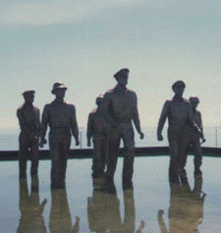 |
 |
Balangiga Massacre and Leyte Landing. Two spectacular events in Leyte-Samar history. Two victories in two different wars, whose respective legacies contradict each other. These two events, taken together, offer contrasting but valuable experiential lessons for the promotion of nationalism among Filipinos in particular and peace education and development in general.
The Balangiga Massacre was the combat victory of bolo-armed Filipino freedom fighters who staged a surprise attack against a company of elite American troops stationed in Balangiga, a town at the southern coast of Samar Island, in the morning of Sept. 28, 1901. The label for the U.S. Army's "worst single defeat" during the Philippine-American War was provided by the Americans themselves.
The Americans retaliated with a "kill and burn" campaign conducted by a battalion of U.S. Marines in the southern part of Samar. The counter-massacres and mayhem resulted in significant decimation of the local population and massive destruction of their economic base (burned houses and food stocks, destroyed native boats, killed carabaos, etc.).
The Filipino victory in Balangiga and the American atrocities in its aftermath were taboo topics for discussion during the American colonial years. And the people of Balangiga themselves could not officially celebrate their forebears' testament to freedom until 1989.
In contrast, the Leyte Landing of the Allied Forces under General Douglas MacArthur on Oct. 20, 1944 was equated with the victory of the Americans against the Japanese during World War II. It was one victory declared before the actual fighting. In fact, it was the victory in the wider Battle for Leyte Gulf, and not the Leyte Landing itself, that spelled the American triumph. After all, the Americans still had to fight a bloody ground war that lasted many weeks in Leyte. (The Battle for Leyte Gulf, considered the "greatest battle in the history of naval warfare," was fought from Oct. 22-27, 1944, and resulted in the decisive rout of the Japanese air and naval forces.)
Yet it was Oct. 20 that was foisted upon the local population and commemorated every year thereafter, to glorify MacArthur and memorialize the role of the Filipinos as loyal lackeys of the Americans.
This artificial legacy of the Leyte Landing crumbled like a house of cards in 1994, during the eve of the 50th anniversary celebration of that event. It could hardly stand on its own merit when confronted with the Balangiga legacy in the mass media, despite the damage-control efforts of government officials and bureaucrats at all levels and the infusion of millions of public funds to create a fiesta atmosphere.
Instead, the ugly but real legacy of the Leyte Landing surfaced. As if a repeat of 1944, many invited Filipino veterans actually starved during the celebration and Major Alejandro Balderian, the popular guerrilla leader whose leadership the locals looked up to during the war years, was again deprived of the official honors due him. It did not help that the actor who played the role of General MacArthur also stumbled into the water upon alighting from the landing barge during the Leyte Landing reenactment.
Bereft of its artificial legacy, the Leyte Landing event has lost much of its appeal, despite the hundreds of thousands of pesos that the province of Leyte continues to plow into its anniversary every year. In contrast, the Balangiga event has emerged as the more relevant regional symbol of the Filipino quest for freedom and nationalism. Its commemoration is drawing a bigger crowd every year and has become more prominent in the public mind.